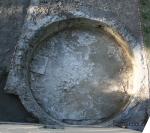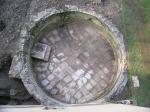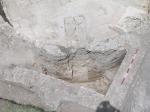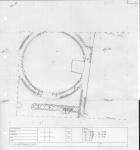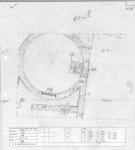Interpretation
-
- laconicum walls with later phases
-
- Dirk Booms
- 24-7-2009
Stratigraphic Relationships
- No Linked Records
Description
- circular structure
- wall
- good
- opus mixtum vittatum
- On exterior, 9 cm plaster with marble veneer on east; 2 coats of white plaster at NE on curve. On interior, white plaster (hydraulic?); cramps for marble revetment.
- trench: 6.60 diameter
- lime concrete, small black pozz.
- yellow porous tuff
- reticulate: 1.5; brick 2.0
- light orangish pink, several sizes employed
- medium-hard light bluish gray
- reticulate: 10 cm; brick 5.5-6 cm
- reticulate: 36; brick: 32
- Circular structure in vittatum mixtum with walls running in southern and northern direction (B and C). (a) The circular structure is built with purely latericium foundation 98 cm up from the current floor and then the remainder of the structure displays the typical reticulatum with brick-coursed vittatum quoins. The bricks of the lower portion are of two sizes, one +/-6 cm thick, one +/- 3 cm thick. The thicker bricks are primarily employed in the 3 top-most courses of the latericium portion but never comprise an entire consistent course all the way around the room. The bricks are laid as sawed triangles facing a cement and rubble core. In the reticulate of the NE section are three built put log holes consisting of a voided cubilia with its upper half filled with a cut brick, thus fomring a downward pointing triangle. The three putlog holes are not evenly spaced in the reticulate fabric; rather, two are only 15 cm apart while the third is another 70 cm to the east. To the south and slightly off-axis to the east, an opening in the latericium portion is vaulted with an arch of vertically laid sesquipedales. The arch must have protruded somewhat into the reticulate above, but to what extent is not clear as the center of the arch is destroyed. This has been interpreted as the praefurnium intake. In the latericium portion at heights of 50 and 20 cm from the extant floor are 3 thick iron cramps built into the courses of bricks. These appear original and probably were intended to hold a revetment though confusingly at the level below the praefurnium and thus below the original floor. They have been bent flush with the wall perhaps in relation to the later application of white plaster to the latericium. Originally access was made to the room through doors to the north, east, and south. The possibility of a door to the west has been obscured by the destruction of the original floor level at that point. The north and east doors were 1.48 m across; the south was 1.16 m. The floor level for these entrances was the beginning of the opus mixtum and the thresholds now gone except the east (see below) presumably would have been laid onto the upper course of brick. The north door is blocked by the modern construction of the overlying casale south wall. The south door is blocked by a wall of opus latericium of smaller triangular bricks 4.5-5.5 cm thick and +/- 17 cm long. The blocking wall shows a high level of consistency of brick size. The east wall is blocked but preserves a segment of the broken threshold of solid cement 18 cm high. The blocking is comprised of a large reused segment of reticulate wall, but with a strange face on the interior showing tuff blocks perhaps old cubiliae laid lengthwise into the wall almost resembling poorly coursed vittatum. In blocking the east door, the northern quoin was badly damaged and repaired with poorly constructed reticulatum. On the exterior of the east door, the doorstep/threshold sits on top of the mosaic pavement 6250 which otherwise runs to the marble revetment of the wall. The bond between (a) and (b) is entirely of latericium rather than the normal vittatum quoins, perhaps owing to the acute angle of juncture. The modern drain cut 6232 runs through the wall of the laconicum piercing a hole through the NE corner of the wall and presumably emptied into the round structure.
- masonry
- Roman

